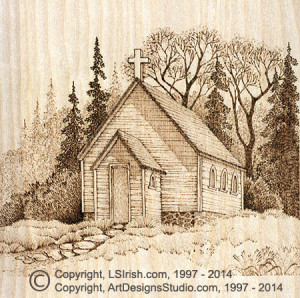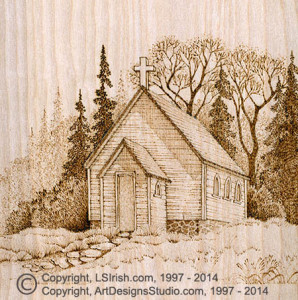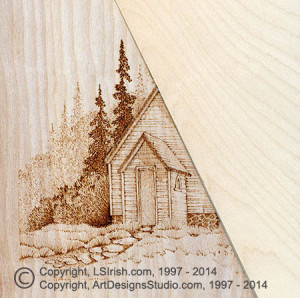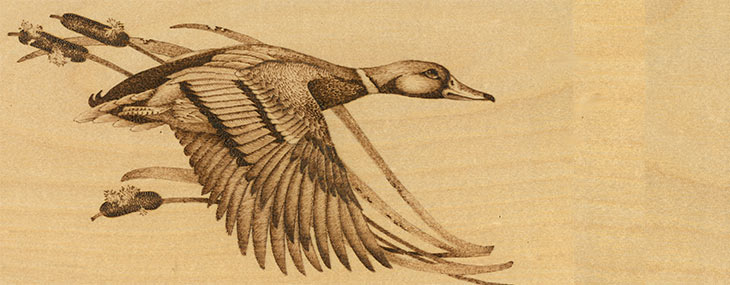 With time and age your wood burning and pyrography designs appear to fade into the wood, losing those sharp, dramatic contrasts and very pale tonal values. Recently, while cleaning our studio, I came across several of my very first wood burned projects, which are perfect examples of how as wood ages it develops a distinct patina which directly affects to look of our wood burning tonal values.
With time and age your wood burning and pyrography designs appear to fade into the wood, losing those sharp, dramatic contrasts and very pale tonal values. Recently, while cleaning our studio, I came across several of my very first wood burned projects, which are perfect examples of how as wood ages it develops a distinct patina which directly affects to look of our wood burning tonal values.
This Country Church, right, was burned in 2004 for the Great Book of Woodburning. It is worked on birch plywood using a variable temperature burning unit and a looped tip pen. The image that you see is from the original scan made for this book.
Notice how clean and white the background wood appears. The burning shows as a neutral dark brown to pale beige hue, and there is a wide range of tonal values throughout the burning.
 Here is a scan, made this morning, of the same wood burning, ten years later. The birch has taken on a rich pale red hue and a darker tonal value in the grain lines. With age and time, wood naturally darkens in tonal value, and the results of that darkening process is called patina.
Here is a scan, made this morning, of the same wood burning, ten years later. The birch has taken on a rich pale red hue and a darker tonal value in the grain lines. With age and time, wood naturally darkens in tonal value, and the results of that darkening process is called patina.
When the wood grain is exposed to air the wood literally begins to rust through oxidation. The minerals in the natural oils and sap begin to darken into deep orange, red, and rust tones, changing the coloring of both your wood and your wood burning.
In the 2014 scan of this Country Church pyrography you can see the red tones of the oxidized patina. Because that patina is behind the burned lines and shading of the pyrography work, the burned design has also taken on a reddish tone.
Since all of us wish for our pyrography projects to last the test of time, at the very start of your next project you need to consider and adjust for the patina that your wood will develop in the years to come. Sugar pine will darken to a deep, rich orange coloring. Your fresh white basswood will move into the yellow-beige tones, and the neutral beige of your birch will become a medium rusty-red with time. Poplar can move into golden-yellow hues and a freshly cut piece of pink-beige mahogany can become almost black-red within a decade or two.
By knowing what patina color your wood will finally develop, you can plan ahead to work your tonal values in the darker ranges to adjust for aging. You may also need to adjust your pale tonal values. Notice in the two images, right, that the fine grass in the foreground, just below the church door is beginning to disappear. The original temperature setting for this grass created a pale burn line that now is close to the patina tonal values of the wood.
 While the two burned images, above, may not seem that dramatic, when I do a side-by-side comparison of the ten-year old Country Church burning against a new, fresh piece of birch plywood you can see it’s not the burning that has faded but the wood that has darkened.
While the two burned images, above, may not seem that dramatic, when I do a side-by-side comparison of the ten-year old Country Church burning against a new, fresh piece of birch plywood you can see it’s not the burning that has faded but the wood that has darkened.
You can not avoid a wood developing a darker patina with time, but you can delay it. Which wood finish you use can change the coloring of the wood. Oil finishes and some varnishes create a pale yellow cast, polyurethane and acrylic sealers then to be very clear. Use a sealer that has UV light protection.
Do not hang or display your finished projects in direct sunlight, nor directly near a heat source as the furnace vent or under a high wattage lamp.
Normal accumulation of dirt and oil can added to the effects of aging. Lightly wash the surface of your projects with a damp, slightly soapy cloth, then rinse with a lightly dampened cloth. For heavy dirt use Murphy’s Oil Soap. It’s excellent for both wood burnings and wood carvings.

